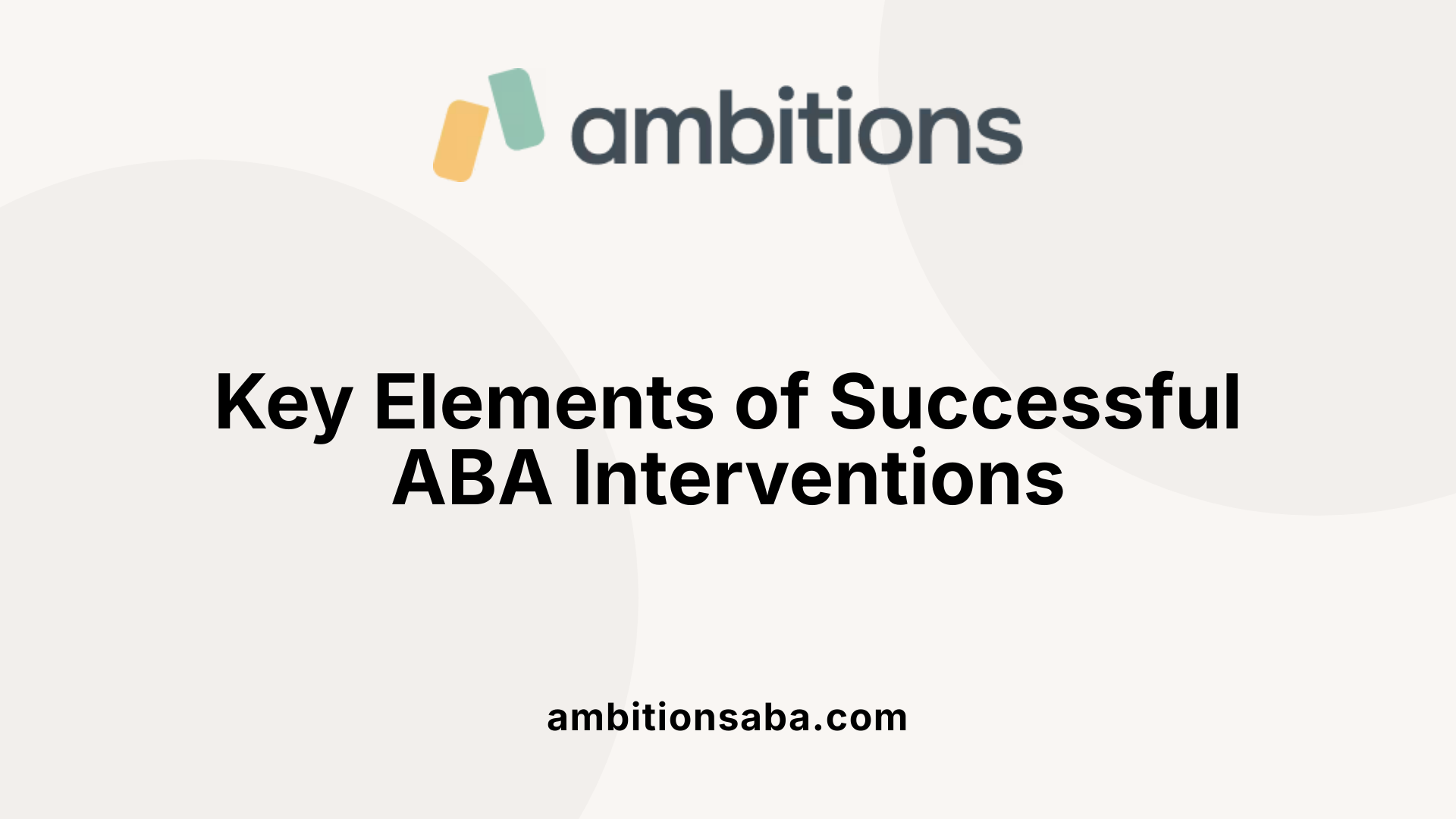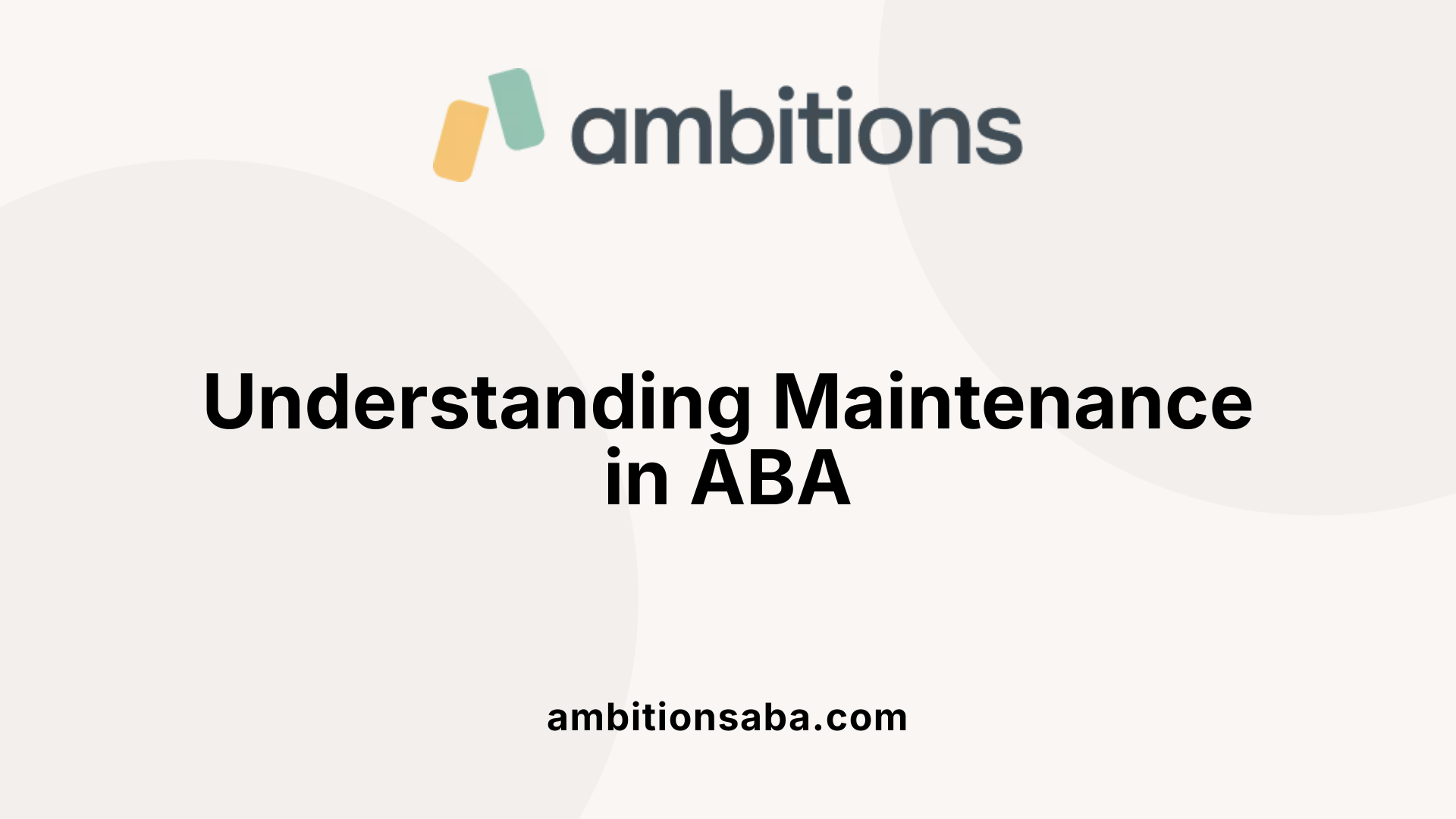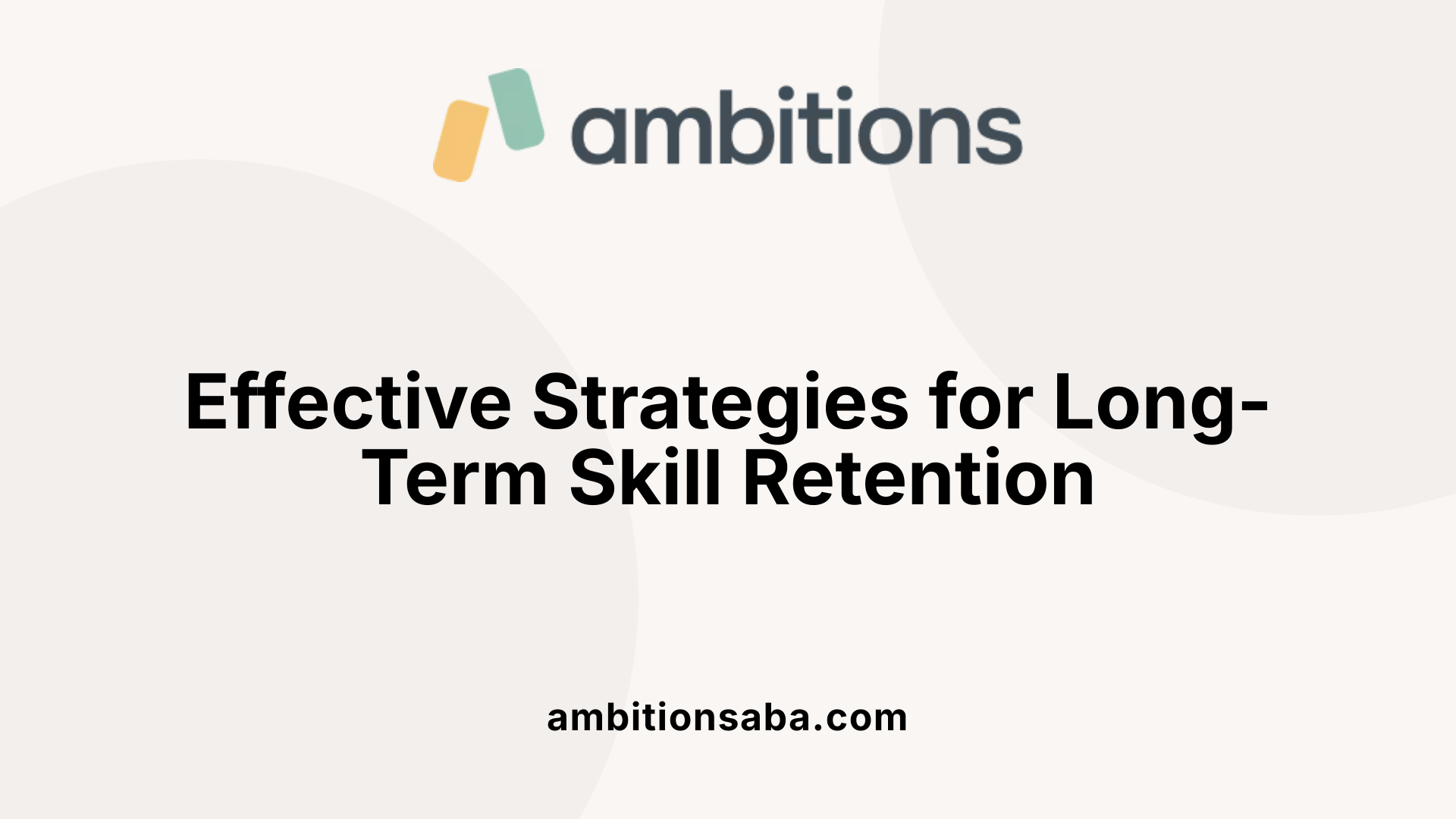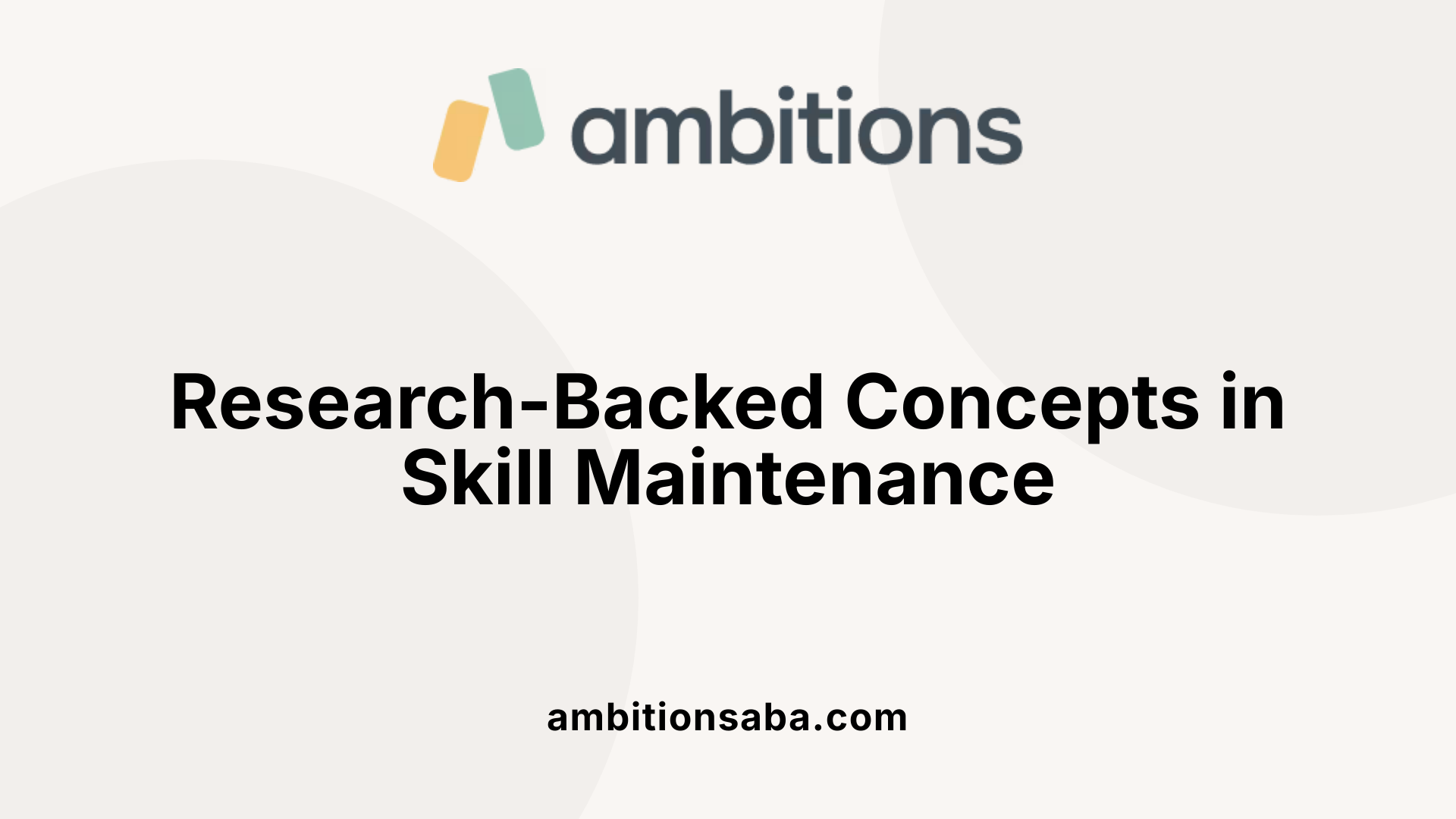Unlocking the Secrets of Persistent Drive
Understanding Maintenance in ABA and Its Significance
In Applied Behavior Analysis (ABA), the concept of maintenance is fundamental to achieving enduring behavioral change. It pertains to the retention and performance of skills over time, even after formal teaching and reinforcement have ceased. This article explores what maintenance entails, why it is crucial in ABA, and how practitioners can promote and assess it effectively to ensure that skills learned are not fleeting but become integrated into everyday life.
Core Components of Effective ABA Programs

What does the 'maintenance' part of ABA programming involve?
In ABA therapy, maintenance refers to the process of ensuring that skills learned are retained over time and can be performed independently, without constant prompts or reinforcement. It involves practicing mastered skills regularly to prevent regression and to solidify the individual's ability to use these skills in daily life.
Maintenance isn't just about repetition; it's about making sure skills remain functional and meaningful. For example, a child who learns to use a visual schedule to navigate their day benefits when that skill continues to enable them to independently manage daily routines even after the structured teaching phase ends.
How do programs ensure skills are sustainable?
Programs include activities that focus on periodically practicing these skills in natural settings — at home, at school, or within the community. This natural reinforcement helps the skills to stick and become automatic, increasing their usefulness in real-world situations.
Research supports this approach, suggesting that using intermittent reinforcement schedules during teaching makes behaviors more resistant to extinction. This means behaviors are more likely to persist over time, especially when reinforcement occurs sporadically, mimicking natural environments.
Why focus on functional and meaningful skills?
Skills targeted for mastery should be useful and applicable in everyday life. Practicing skills that are not used naturally could lead to poor retention, as they lack relevance to the individual’s daily routines.
Incorporating skills that reflect real-life needs encourages ongoing practice in natural contexts, which enhances maintenance and generalization. For instance, teaching a child to request help in a specific setting is more likely to be maintained if they frequently encounter that situation.
Strategies to promote maintenance
Therapists can use several techniques to support long-term retention. These include gradually fading prompts and cues, reducing artificial reinforcement, and fostering the natural consequences that occur in everyday environments.
Three main approaches include:
| Strategy | Description | Example |
|---|---|---|
| Withdrawing antecedents | Removing cues or prompts | Gradually reducing visual supports |
| Fading task requirements | Increasing independence | Moving from hand-over-hand assistance to independent work |
| Withdrawing reinforcement | Transitioning to natural rewards | Using naturally occurring praise or outcomes |
Combining these approaches helps children sustain and transfer skills to new settings and situations.
The importance of generalization
Generalization—the ability to perform skills across different contexts, people, and environments—is crucial. Effective maintenance supports this transfer, ensuring skills are not only retained but also useful across various real-life situations.
Regular assessments and data collection enable therapists and caregivers to identify which skills are maintained and which require reinforcement or additional practice. This ongoing monitoring supports continuous progress.
How does maintenance contribute to overall development?
By focusing on maintenance, ABA programs help children build more complex skills from basic ones, fostering independence and improving quality of life. Maintenance practices also help adapt behaviors to fit changing environments, ensuring that skills remain relevant and functional over time.
In conclusion, integrating maintenance strategies—such as natural reinforcement, fading prompts, and practicing skills in natural settings—ensures that learned skills endure and benefit the individual long term, enabling meaningful and lasting improvements in daily life.
The Foundations and Key Concepts of Maintenance in ABA

What is maintenance in ABA and why is it important?
Maintenance in ABA refers to the continued performance of a skill after it has been initially learned. It ensures that behaviors are retained over time and can be performed across different settings without additional prompts or reinforcement. This aspect of skill development is vital because it transforms temporary learning into lasting, functional behaviors that promote independence and improve the individual’s quality of life.
For children with autism, mastering new skills in therapy sessions does not suffice if those skills are not maintained outside the clinical environment. Without proper maintenance, a child might demonstrate a skill during a session but fail to transfer it to home, school, or community settings. Therefore, ensuring skills are retained over the long term is central to the success of ABA interventions.
How does maintenance differ from skill acquisition?
Skill acquisition is the process of teaching an individual a new behavior or ability, often within a controlled environment. Once a skill has been learned to a predefined criterion, the focus shifts to maintenance.
Maintenance centers around preserving the skill against natural forgetting. Unlike acquisition, which involves introducing new behaviors, maintenance involves ongoing practice, reinforcement, and strategies aimed at preventing regression.
For example, a child might learn to brush their teeth with visual aids and reinforcers during therapy. Maintenance ensures that this skill continues over time, even after formal teaching ends.
Why is retention and long-term performance critical?
Retention ensures that skills continue to exist without constant prompts or reinforcement. Long-term performance is essential because it indicates that the individual can perform the skill autonomously in real-world settings.
Practicing skills in natural contexts encourages the development of behaviors that are flexible and functional. Consistent maintenance efforts lead to better generalization, meaning skills are accessible across various environments, tasks, and social situations.
What mechanisms support maintenance?
Research suggests several mechanisms underlying maintenance. These include interventions like intermittent reinforcement schedules, which reinforce behaviors sporadically rather than continuously. Such schedules help behaviors resist extinction and promote durable learning.
Fading prompts gradually, reducing dependence on external cues, also supports maintenance. Additionally, practicing skills in natural environments with natural reinforcement fosters meaningful retention.
What factors influence maintenance?
Several elements can affect how well a skill is maintained:
- Practice frequency: Regular practice in natural settings helps solidify skills.
- Reinforcement type: Natural reinforcement—where the behavior produces naturally occurring consequences—encourages longer-lasting behaviors.
- Skill relevance: Skills that are functional and meaningful are more likely to be retained.
- Prompts and reinforcement fading: Gradual removal of prompts and scaffolding ensures skills are not dependent on external cues.
- Environmental consistency: Practicing across different settings and with various people promotes generalization and maintenance.
By understanding and applying these factors, therapists can design effective maintenance programs that sustain and generalize skills, ultimately supporting the individual’s independence and success in daily life.
Strategies to Promote Skill Maintenance

What strategies can help promote response maintenance in ABA therapy?
In ABA therapy, maintaining skills over time is crucial for ensuring that learned behaviors are functional and sustainable. One effective approach involves gradually fading prompts, cues, and reinforcement to reduce reliance on external stimuli. For example, therapists progressively remove prompts or reminders during teaching sessions, encouraging learners to perform skills independently. This process, known as prompt fading, helps solidify the skill as part of the child's natural repertoire.
Incorporating natural reinforcement strategies is also vital. Reinforcers derived from the child's environment—like praise, access to preferred activities, or tangible rewards—are used to support skill retention. Practicing skills in natural settings, such as at home or school, ensures that behaviors are relevant and more likely to be maintained outside therapy sessions.
Embedding maintenance into daily routines helps integrate skills into the child's life. When skills are linked with regular activities—like brushing teeth during morning routines or requesting items during snack time—they become habitual parts of daily life, increasing the likelihood of long-term retention.
Another important strategy is the gradual withdrawal of assistance or support. Therapists might start with full prompts and gradually reduce assistance until the learner performs the skill autonomously. This structured fading process ensures the child’s response becomes independent while retaining the skill.
Booster sessions, scheduled periodically after mastery, serve as review opportunities to reinforce skills. These sessions help prevent skill regression and ensure ongoing mastery as the child's environments and needs evolve.
Effective maintenance strategies also involve ongoing assessment. Regular probes and observation allow therapists to monitor retention and address any skill decline promptly. By varying practice conditions—such as changing settings, people, or materials—learners develop a flexible understanding and application of skills across different situations.
Involving caregivers in training and coaching ensures that strategies used in therapy are applied consistently at home, further supporting the maintenance of skills. Overall, combining these methods creates a robust framework that fosters durable, functional skills capable of lasting over time and across environments.
Assessment and Evaluation of Maintenance
How can response maintenance be assessed and evaluated in ABA?
Response maintenance in ABA refers to the ability of a learner to retain and perform a learned skill over time without ongoing prompts or reinforcement. To evaluate this, therapists use scheduled maintenance probes, which are planned assessments conducted at various intervals after the initial teaching phase. These probes involve observing the individual performing the skill in natural settings or controlled environments to see if the behavior persists.
Data collection plays a central role in this process. Practitioners gather detailed information on performance during follow-up sessions, noting consistency, accuracy, and independence in executing the skills. Analyzing this data helps determine whether the behavior has been maintained or if it requires additional reinforcement or instruction.
Promoting effective maintenance also involves setting appropriate mastery criteria before transitioning away from direct supervision. Higher standards, such as achieving 90-100% accuracy across multiple sessions, tend to support better skill retention. When mastery criteria are rigorous, learners are more likely to sustain behaviors over time.
In addition to structured probes, observing behavior during natural activities is crucial. This includes assessing whether the individual carries the skill into different settings and with various people—an essential element of generalization. Consistent measurement of performance across diverse environments provides comprehensive data on the durability and versatility of the acquired skills.
Scheduled maintenance probes
Scheduled maintenance probes are systematically planned to gauge how well skills are retained over weeks or months. These probes help identify any early signs of skill decline, allowing intervention adjustments.
Data collection and analysis
Reliable data collection involves recording performance metrics such as accuracy percentages and independence levels. Analyzing trends over multiple assessments reveals patterns of retention and indicates whether training gaps exist.
Skill retention over time
Long-term retention signifies that the learner can still perform the skill well after the initial instruction phase has ended. Repeated assessments confirm stability and help inform decisions about the need for booster sessions.
Generalization across environments
Effective maintenance is closely tied to generalization. Skills that are practiced and reinforced in varied natural settings, with different people, are more likely to be retained and used across contexts.
Role of mastery criteria
Mastery criteria define when a skill is considered sufficiently learned, often based on performance standards like 90% accuracy over multiple sessions. Setting high mastery thresholds promotes durability, as learners demonstrate consistent, reliable performance before moving onto new skills.
| Aspect | Description | Implementation Details |
|---|---|---|
| Scheduled Probes | Regular assessments of skill retention | Conduct at set intervals (e.g., weekly, monthly) in natural settings |
| Data Collection | Gathering performance metrics | Record accuracy, independence, and contextual application |
| Skill Retention | Ability to perform skills over time | Longitudinal tracking, repeated measures |
| Generalization | Applying skills across different environments | Practice in multiple settings and with various people |
| Mastery Criteria | Standards for defining skill mastery | 90-100% accuracy across sessions |
Focusing on these components ensures that learned skills are not only retained but also functional and meaningful in the learner's daily life, supporting long-term success in ABA interventions.
Research and Theoretical Insights into Maintenance

What is the significance of generalization and maintenance in ABA?
In Applied Behavior Analysis (ABA), both generalization and maintenance are fundamental for translating taught skills into meaningful, real-life functions. Generalization refers to the ability of a learner to apply learned behaviors across different settings, stimuli, people, and variations in response. This ensures that skills are not confined to the clinical or teaching environment but are useful and applicable elsewhere.
Maintenance, on the other hand, involves the continued performance of a skill over time after the instructional intervention has ended. It is crucial because it prevents regression, supports long-term mastery, and demonstrates that the learner has truly acquired the skill. Without proper maintenance, skills learned may be lost when reinforcements or prompts are withdrawn.
Together, these concepts ensure that small, initially taught behaviors evolve into larger, functional skills that enhance independence. For example, teaching a child to brush teeth with visual schedules and reinforcement is only the start. With effective maintenance and generalization strategies, this skill can be sustained and performed across different settings like home and school, with various people, thus improving overall quality of life.
Strategies to promote generalization include training with multiple exemplars, programming common stimuli, and practicing skills in natural environments. For maintenance, fading prompts, reducing artificial reinforcement, and promoting natural consequences are essential. This ensures that learned behaviors are durable, adaptable, and truly beneficial, forming the cornerstone of effective ABA intervention.
Conclusion and Practical Takeaways
 In ABA therapy, maintenance refers to the ability of a learner to retain and perform a skill over time without continuous prompts or reinforcement. This aspect ensures that skills are not only learned but also preserved, allowing for long-lasting effects that support independence.
In ABA therapy, maintenance refers to the ability of a learner to retain and perform a skill over time without continuous prompts or reinforcement. This aspect ensures that skills are not only learned but also preserved, allowing for long-lasting effects that support independence.
The maintenance component of ABA programs typically emphasizes skills that have been mastered and need consistent practice to prevent regression. These are behaviors that are functional and relevant to the learner's daily life, aligning with principles of functional skill development.
Teaching skills that will be frequently used in real-world settings increases the likelihood of natural reinforcement, making the skills more likely to be maintained. For example, teaching a child to tie shoelaces not only involves mastery but also regular practice in daily routines, which helps solidify the behavior.
Research supports the use of intermittent reinforcement schedules during teaching, as behaviors reinforced intermittently tend to resist extinction better. This strategy helps in promoting the durability of skills over time.
However, skills not used in natural environments may not need regular maintenance practices, indicating their limited functional relevance. Practicing skills that are outside routine contexts could lead to unnecessary effort unless they hold meaningful value for the learner.
In some cases, maintenance routines act as a fallback or support for staff, especially during transitions to more complex or difficult targets. They can also serve as part of behavioral momentum strategies, making it easier to introduce new skills.
Overall, the goal of maintenance is to ensure that learned skills are functional, meaningful, and resistant to regression. Employing evidence-based reinforcement strategies, such as natural reinforcement and faded cues, can support this goal.
Practical implementation involves gradually fading prompts, withdrawing unnecessary reinforcement, and promoting natural consequences. These steps help in fostering skills that are retained and generalized across different environments, such as home and school.
Monitoring progress through regular assessments and data collection is essential. It helps identify which skills are maintained and which may require additional reinforcement or practice to prevent loss.
Finally, promoting maintenance is a foundational element for achieving lasting independence. When skills are maintained over time and across settings, they significantly enhance the individual’s ability to function effectively and confidently in daily life.
Fostering Long-Term Success Through Strategic Maintenance
In ABA therapy, maintenance is the cornerstone of achieving lasting behavior change. It transcends initial skill acquisition by ensuring that skills are retained and functional in real-world situations over time. Employing evidence-based strategies such as fading prompts, practicing in natural environments, and involving caregivers can significantly enhance skill durability. Regular monitoring and assessment help tailor interventions, reducing the risk of regressions and supporting generalization across settings and people. By prioritizing maintenance, therapists and families work together to empower individuals with autism to develop independent, meaningful skills that improve their quality of life and promote lifelong learning. Ongoing research continues to refine these approaches, contributing to more effective, sustainable intervention models, and ensuring that behavioral progress is both durable and meaningful.
References
- What about maintenance programs?
- Effective ABA Maintenance Techniques for Lasting Results
- Generalization and Maintenance in Applied Behavior Analysis
- 5 Essential Aspects of Maintenance ABA Definition You Should Know
- Mastery Criteria and Maintenance: a Descriptive Analysis of Applied ...
- Maintenance - ABA Study Guide
- The Importance of Generalization and Maintenance in ABA Therapy
- B-12: Define and provide examples of motivating operations
- What are Motivating Operations (MOs)? | Autism Resources

